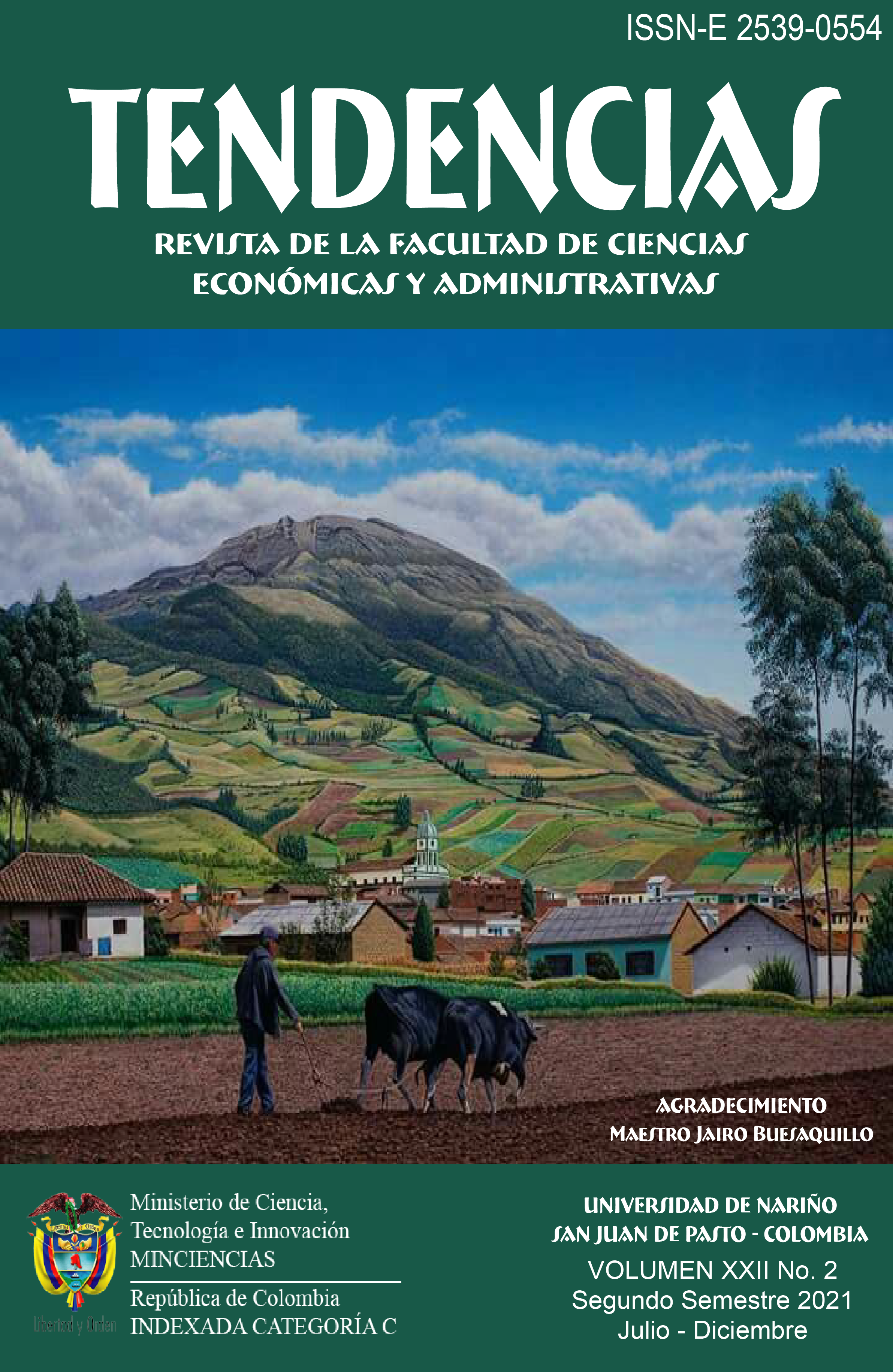Entrepreneurial intention in undergraduate students at the University of Nariño, Colombia
DOI:
https://doi.org/10.22267/rtend.212202.174Keywords:
businessman, university students, Colombia, educational programsAbstract
This research addresses an analysis of the entrepreneurial intention in students who are completing their undergraduate studies at the University of Nariño and are part of professional programs related to world-class sectors. The type of research is exploratory and descriptive; It is intended to explore and describe what are the behavioral, normative and controlled beliefs of students and how these beliefs influence entrepreneurial intention. The information was obtained from a sample of 293 students belonging to different undergraduate programs. The results indicate that in most of the students who participated in the research, there is a high entrepreneurial intention. Their close environment, especially family, encourages them to create their own company, but they consider factors such as little state support, the limitations that the university has to provide adequate spaces to generate business ideas and ignorance of ideation methodologies, negatively affect your entrepreneurial intention.
Downloads
References
(1) Ajzen, I. (1991). The theory of planned behavior. Organizational Behavior and Human Decision Processes, 50(2), 179-211. https://doi.org/10.1016/0749-5978(91)90020-T
(2) Aldana-Rivera, E. E., Tafur-Castillo, J., Gil, I., & Mejía, C. (2019). Práctica pedagógica de emprendimiento en docentes de educación superior en Institución Educativa Universitaria de Barranquia. Archivos Venezolanos de Farmacología y Terapéutica, 38(2), 9-22. http://www.redalyc.org/articulo.oa?id=55964524002
(3) Azqueta, A. (2017). El concepto de emprendedor: origen, evolución e introducción. Simposio Internacional El Desafío de Emprender en la Escuela del Siglo XXI, Sevilla, España. https://hdl.handle.net/11441/74177
(4) Baggozi, R., Baumgartner, J., & Yi, Y. (1989). An investigation into the role of intentions as mediators of the attitude-behavior relationship. Journal of Economic Psychology, 10(1), 35-62. https://doi.org/10.1016/0167-4870(89)90056-1
(5) Baron, R. A. (2007). Behavioral and cognitive factors in entrepreneurship: Entrepreneurs as the active element in new venture creation. Strategic Entrepreneurship Journal, 1(1–2), 167–182. https://doi.org/10.1002/sej.12
(6) Bechard, J., & Toulouse, J. (1998). Validation of the didactic model for the analysis of training objectives in entrepreneurship. Journal of Business Venturing, 13(4), 317-332. https://doi.org/10.1016/S0883-9026(98)80006-2
(7) Bird, B. (1988). Implementing entrepreneurial ideas: the case for intention. Academy of Management Review, 13(3), 442-453. https://doi.org/10.5465/amr.1988.4306970
(8) Davidsson, P. (1995). Determinants of entrepreneurial intentions. RENT IX Workshop, 1-31.
(9) Durán-Aponte, E. y Arias-Gómez, D. (2015). Intención emprendedora en estudiantes universitarios: integración de factores cognitivos y socio-personales. Revista Colombiana de Ciencias Sociales, 6(2), 320-340. https://doi.org/10.21501/22161201.1528
(10) Fayolle, A., & Gailly, B. (2008). From craft to science: Teaching models and learning processes in entrepreneurship education. Journal of European Industrial Training, 32(7), 569-593. https://doi.org/10.1108/03090590810899838
(11) Fiduciaria Colombiana de Comercio Exterior [FIDUCOLDEX]. (2017). Programa de Transformación Productiva. https://www.fiducoldex.com.co/sites/default/files/invitaciones-archivos-pdf/TRD%20PRODUCTIVIDAD%2014-09-2017.pdf
(12) Galleguillos-Cortés, C., Escobar-Burgos, B. y Hurtado-Cailly, R. (2019). Predictores de la Intención Emprendedora en Alumnos de Pregrado: Un Modelo Basado en Ecuaciones Estructurales. Formación Universitaria, 12(1), 83-94. http://dx.doi.org/10.4067/S0718-50062019000100083
(13) Gibb, A. (1988). Stimulating new business development (what else besides EDP?). ILO.
(14) Gómez, M. E. (2019). Emprendimientos de base tecnológica: un reto por cumplir. TEC Empresarial, 13(2), 33-44. https://dx.doi.org/10.18845/te.v13i2.4493
(15) Gutama, M. G. y Jiménez, P. (2019). El emprendimiento y su evolución como una alternativa laboral en el contexto latinoamericano: una revisión de la literatura [Trabajo de pregrado]. Universidad de Cuenca. https://dspace.ucuenca.edu.ec/bitstream/123456789/31772/1/EL%20EMPRENDIMIENTO%20Y%20SU%20EVOLUCI%C3%93N%20COMO%20UNA%20ALTERNATIVA%20LABORA.pdf
(16) Hannon, P. (2013). Why is the Entrepreneurial University Important? Journal of Innovation Management, 1(2), 10-17.
(17) Hernández, R., Fernández, C. y Baptista, M. (2014). Metodología de la Investigación (6ªed.). Mc Graw Hill.
(18) McClelland, D. (1961). The Achieving Society. Princeton.
(19) Moriano, J., Trejo, E. y Palací, F. (2001). El perfil psicosocial del emprendedor: un estudio desde la perspectiva de los valores. Revista de Psicología Social, 16(2), 229-242.
(20) Oficina de Registro y Control Académico [OCARA]. (2017, Semestre B). Universidad de Nariño.
(21) Osorio, F. y Londoño, J. (2015). Intención emprendedora de estudiantes de educación media: extendiendo la teoría de comportamiento planificado mediante el efecto exposición. Cuadernos de Administración, 28(51), 103-131.
(22) Ruiz, C. (2014, febrero 15). Los principales desafíos de los 20 sectores de clase mundial. La República. https://www.larepublica.co/archivo/los-principales-desafios-de-los-20-sectores-de-clase-mundial-2102556
(23) Sánchez, J. C., Lanero, A. y Yurrebaso, A. (2005). Variables determinantes de la intención emprendedora en el contexto universitario. Revista de psicología social aplicada, 15(1-2), 37-60.
(24) Sánchez, J. C., Ward, A., Hernández, B. y Flórez, J. L. (2017). Educación Emprendedora: estado del arte. Propósitos y Representaciones, 5(2), 401-473. http://dx.doi.org/10.20511/pyr2017.v5n2.190
(25) Schumpeter, J. A. (1934). The theory of economic development. Harvard University Press.
(26) Shapero, A. T. (1985). The entrepreneurial event. College of Administrative Science, Ohio State University
(27) Shapero, A., & Sokol, L. (1982). The Social dimensions of entrepreneurship. Encyclopedia of Entrepreneurship. http://ssrn.com/abstract=1497759
(28) Tarapuez-Chamorro, E., Flórez-Laiseca, A. M. y Giraldo-Correa, M. P. (2019). Intención emprendedora en Colombia: el caso de los estudiantes de Maestría en Administración. Revista Escuela de Administración de Negocios, (86), 93-113. https://doi.org/10.21158/01208160.n86.2019.2292
(29) Thornton, P. H. (1999). The sociology of entrepreneurship. Annual review of sociology, 25, 19-46. https://doi.org/10.1146/annurev.soc.25.1.19
(30) Valencia, A., Montoya, I. y Montoya, A. (2016). Intención emprendedora en estudiantes universitarios: Un estudio bibliométrico. Intangible Capital, 12(4), 881-922. http://dx.doi.org/10.3926/ic.730
(31) Varela, R. (2008). Innovación empresarial: Arte y ciencia en la creación de empresas (3ªed.). Pearson Educación de Colombia Ltda.
Published
How to Cite
Issue
Section
License
Those authors who have publications with this journal, accept the following terms:
This journal is licensed under a Creative Commons Reconocimiento-NoComercial 4.0 Internacional License. The articles can be copied, distributed, adapted and communicated publicly, as long as the credits of the work are recognized and the respective source is quoted. This work can not be used for commercial purposes.
To increase their visibility, documents are sent to databases and indexing systems.
The content of the items is the responsibility of each author, and does not compromise in any way, journal or institution.







































